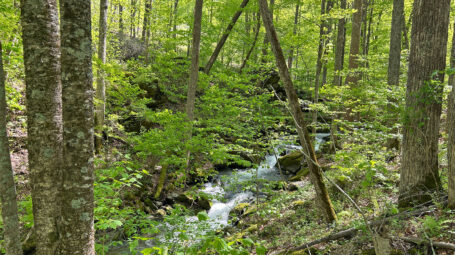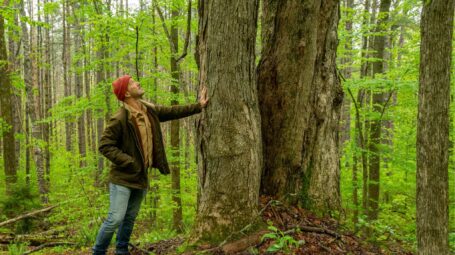Forest, past and future
5 min read / November 5, 2024
Our website uses cookies to improve your experience. To learn more about how we use cookies, please review our privacy policy.
Can't find what you're looking for? Please contact us.
In 1997, a 33-year-old forester got a job managing 26,000 acres of rugged forestland in northern Vermont. What happened next redefined his career and shaped how VLT practices forest management today.
VLT and The Nature Conservancy in Vermont (TNC-VT) had bought the land from a timber company to gain hands-on experience in forest management for ecological health and timber production. This was new terrain for both conservation organizations: owning and managing land was not, at the time, part of their approach.
Once owned by the Atlas Plywood Corporation, much of the forest had been heavily and steadily logged for decades to supply the company’s mills in Vermont and Maine. Restoring them to a healthier state would not be easy. “Ten years is a tiny blip for a tree,” says David, “and it often takes a lifetime to see change. Trees just grow slow.”
David was full of idealism and brimming with ideas to restore health to the woodlands. He watched and talked shop with the region’s older foresters. Working closely with a team from VLT and TNC-VT, he applied new and old methods and did his best to listen and learn from the land. He spent long winters working steep terrain with his golden retriever pup, Nory, who sometimes barely cleared the deep snow. Nory eventually passed on, but David remained on the land for nearly three decades.
Now on VLT staff, David is ending one of the most significant chapters of his professional career and personal life, and a new chapter is beginning. In 2024, VLT and TNC-VT permanently protected the last remaining parcels they owned and managed together, and transferred them to new ownership.
Most of the land was sold with a VLT conservation easement, but about 2,000 acres in Richford is part of a different outcome. The Northeast Wilderness Trust bought and added that acreage to the adjacent Bear’s Nest Nature Preserve that they own and care for under a forever wild conservation easement, which leaves the land relatively untouched.
Active forest management and minimal intervention are important in caring for this place we call home. Setting aside land for both approaches aligns with the state’s 30×30 conservation vision, which prioritizes using a variety of methods to boost the land’s ability to adapt in a changing climate, store carbon, and host an abundance of lifeforms.
“The partnership between Vermont Land Trust, Northeast Wilderness Trust, and The Nature Conservancy demonstrates how both wildlands and working forest protection can be achieved,” said Eve Frankel, the State Director of TNC-VT. “As all species are forced to adapt to a changing climate it is crucial that we work together to safeguard healthy ecosystems and their clean water, wildlife habitat, and flood resilience benefits.”
Eve noted that the Bear’s Nest Wilderness Preserve permanently protects over 2,700 acres of climate resilient wild forest providing critical wildlife habitat for bears, moose and migratory birds, as well as protecting Richford’s drinking water.
Acquiring nearly 2,000 acres from the VLT-TNC partnership enabled the Northeast Wilderness Trust to establish Bear’s Nest Wilderness Preserve as one of the largest privately-owned tracts of forever-wild forests in Vermont. This part of the forest, which is particularly remote and difficult to access, has remained relatively untouched for some time. Bob Linck, the organization’s Vice President of Conservation Programs, said that with old forest characteristics already developing on this land, it is well-suited to meet the goal of supporting more old forests in priority landscapes.
“We welcomed the opportunity to work with Vermont Land Trust and The Nature Conservancy to achieve complementary goals — permanent protection of both wildlands and woodlands within a large block of forest identified by Vermont Conservation Design as ‘highest priority’ for conservation,” Bob said.
David is grateful all 26,000 acres of forest are permanently protected from development and will continue to provide connections between land and people into the future. He’s especially pleased to know that some of the trees will live out their full lives. The Richford land that is now part of Bear’s Nest includes a yellow birch tree he first encountered 29 years ago — one of the most impressive trees he says he’s ever seen.
“Foresters before me protected this tree, I protected this tree, and now it will be protected for as long it needs to complete its full life cycle,” he says. “That feels really good.”
In managed forests, a growing number of foresters are adopting techniques that help bring some of the benefits of old forests to younger woodlands. These techniques include leaving some mature trees standing, creating breaks in the forest canopy, keeping some downed logs in streams and along the forest floor, and girdling others to become standing dead wood. These practices help woodlands shelter and feed more insects and animals and invite a wider diversity of species. They also make the woods more resilient and adaptable in a changing climate.
David applied many of these ecologically focused forestry techniques at the VLT-TNC partnership timberlands over the years. During that time, he often worked with then Franklin County Forester Nancy Patch. She said that when David oversaw timber harvests, he made sure the loggers left woody materials onsite for wildlife and soil health, and took the time to verify forest conditions in person. He also checked the growth of tree species prone to issues and identified old trees to maintain and keep as legacy trees.
“True forestry is about the future,” Nancy said. “It’s about what you leave and not about what you take. David looked at all of the things that we are now talking about across the landscape regarding old-growth characteristics.”
David says he also learned from people who worked or were connected to the land long before he was born.
“It’s the connections between the land and people that stand out,” he says. “I heard hundreds of stories, some firsthand and others passed down from generation to generation. If only those old trees could talk.”
One man sent him a long letter recounting his time as a logger there in the 1920s. The letter said men slept two to a bed in bunks, and the logs were loaded on sleds pulled by horses. Other people swapped hunting stories and shared their families’ histories.
“My personal evolution from a focus on ‘me’ and ‘now’ to a stewardship ethic of ‘we’ and ‘forever’ was fostered on these lands,” David says.
Now, as the conserved forests welcome new owners and new approaches, we like to think that David’s stewardship ethic and history on the land will live on.








We generally send two emails per month. You can unsubscribe at any time.